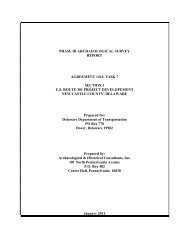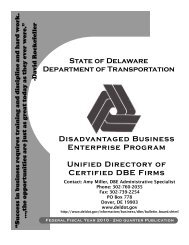Gulph Creek Stone Arch Bridge - Delaware Department of ...
Gulph Creek Stone Arch Bridge - Delaware Department of ...
Gulph Creek Stone Arch Bridge - Delaware Department of ...
Create successful ePaper yourself
Turn your PDF publications into a flip-book with our unique Google optimized e-Paper software.
Chapter 3—Historic Context for Common Historic <strong>Bridge</strong> Types<br />
3.2.2 Reinforced Concrete Melan/von Emperger/Thacher <strong>Arch</strong><br />
History and Description: The first concrete arch bridge in the United States was<br />
a plain, un-reinforced concrete footbridge with a 31-foot span, constructed in Prospect<br />
Park, Brooklyn, New York, in 1871. This little bridge, however, was not to have many<br />
successors. Despite the advantages <strong>of</strong> plasticity and good compressive strength, unreinforced<br />
concrete has little tensile strength, and thus its usefulness for bridge<br />
construction was limited. The path to full exploitation <strong>of</strong> concrete as a building material<br />
lay in the development <strong>of</strong> a system <strong>of</strong> reinforcement that made use <strong>of</strong> the tensile<br />
properties <strong>of</strong> metal.<br />
The oldest reinforced concrete bridge in the United States is the National Historic<br />
Civil Engineering Landmark Alvord Lake <strong>Bridge</strong> (1889) in San Francisco’s Golden Gate<br />
Park (HAER CA-33). It was one <strong>of</strong> two bridges built in San Francisco that were designed<br />
by Ernest L. Ransome (1844-1917), the “father” <strong>of</strong> reinforced concrete construction in<br />
the United States. Reinforced with rods or bars, which were twisted in accordance with<br />
the design Ransome patented in 1884, this modest structure was the predecessor <strong>of</strong><br />
thousands <strong>of</strong> reinforced concrete bridges built across the nation in the twentieth century.<br />
After serving as an apprentice in the family concrete factory in England, Ransome<br />
immigrated to the United States in the late 1860s to exploit his father’s patent for<br />
“concrete stone.” In the early 1870s, while working as superintendent <strong>of</strong> the Pacific <strong>Stone</strong><br />
Company <strong>of</strong> San Francisco, he established a factory to make concrete blocks. According<br />
to Waddell (9, p. 28), Ransome introduced reinforced concrete to America in 1874, but it<br />
was not until 1884 that he received the patent (# 305,226) that became the basis <strong>of</strong> the<br />
Ransome System for reinforcing concrete. Ransome also adapted a concrete mixer to<br />
twist iron bars up to two inches in diameter, believing that twisted bars had greater tensile<br />
strength than smooth round bars. His primary focus was on finding the best way to make<br />
the concrete adhere to the metal.<br />
Hoping to capitalize on his invention in non-bridge applications, he moved to<br />
New York City and opened the Ransome Concrete Company at 11 Broadway Avenue. At<br />
this point, Ransome had clearly left bridge design behind him in favor <strong>of</strong> building system<br />
development. The Ransome system proved to be very popular for building construction,<br />
and several notable buildings were erected using it, including the Artic Oil Works in San<br />
Francisco, California (1884), an early American reinforced concrete building; the Leland<br />
Stanford Junior Museum in Palo Alto, California (1894), the largest reinforced concrete<br />
public building in the world at the time; and the Ingalls Building in Cincinnati, Ohio<br />
(1903), the first reinforced concrete skyscraper.<br />
In 1902, Henry C. Turner, a former Ransome assistant, founded the Turner<br />
Construction Company and began fully exploiting the Ransome System. Apparently<br />
Turner had acquired some rights to the Ransome patent. Ransome continued to work on<br />
his own, however, and the Foster-Armstrong piano factory in Rochester, New York, was<br />
built in 1905 according to the “Ransome-Smith reinforced concrete method.” The<br />
“Smith” in the name referred to borax king Francis M. Smith, who, along with Ransome,<br />
3-53






